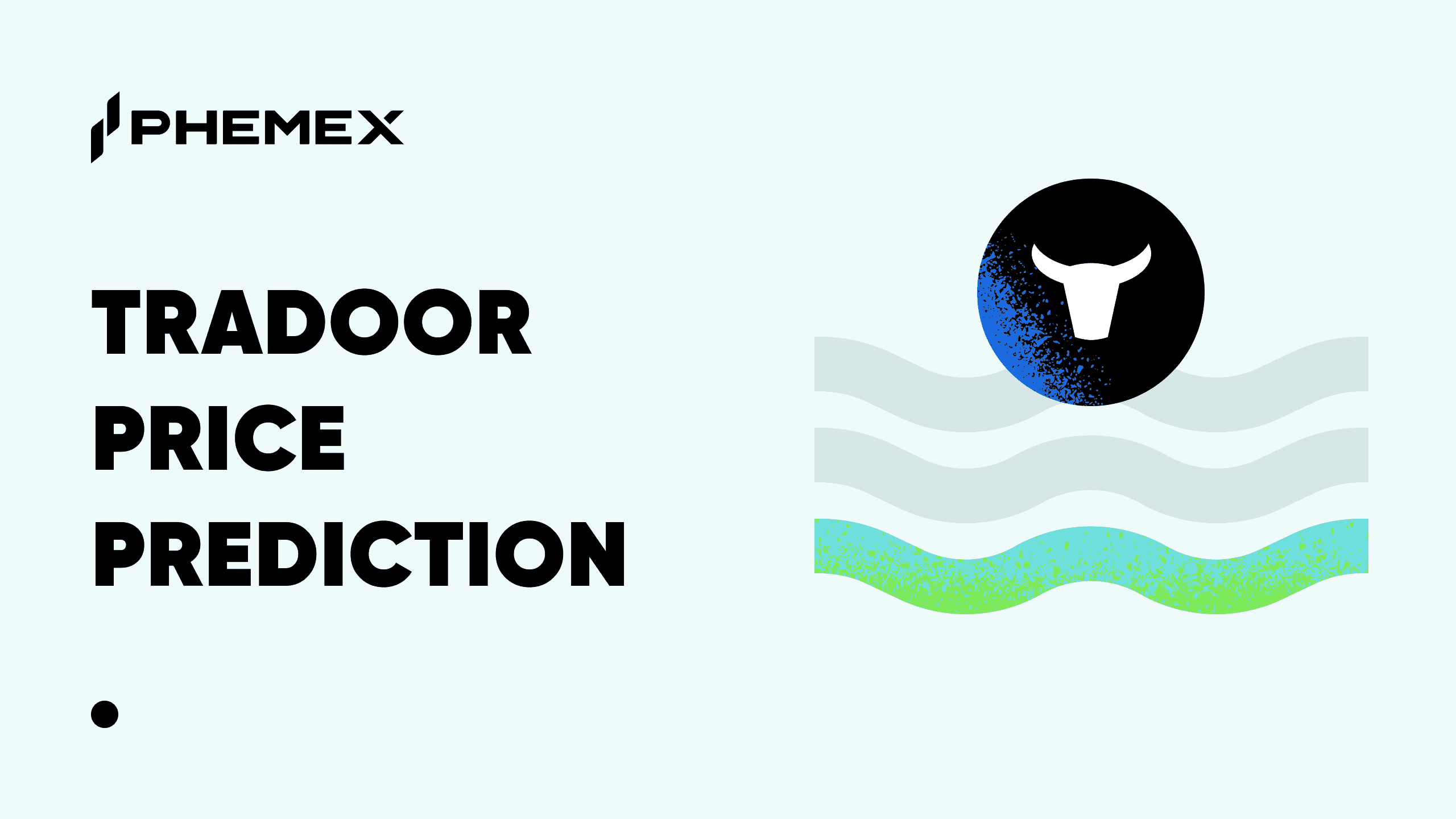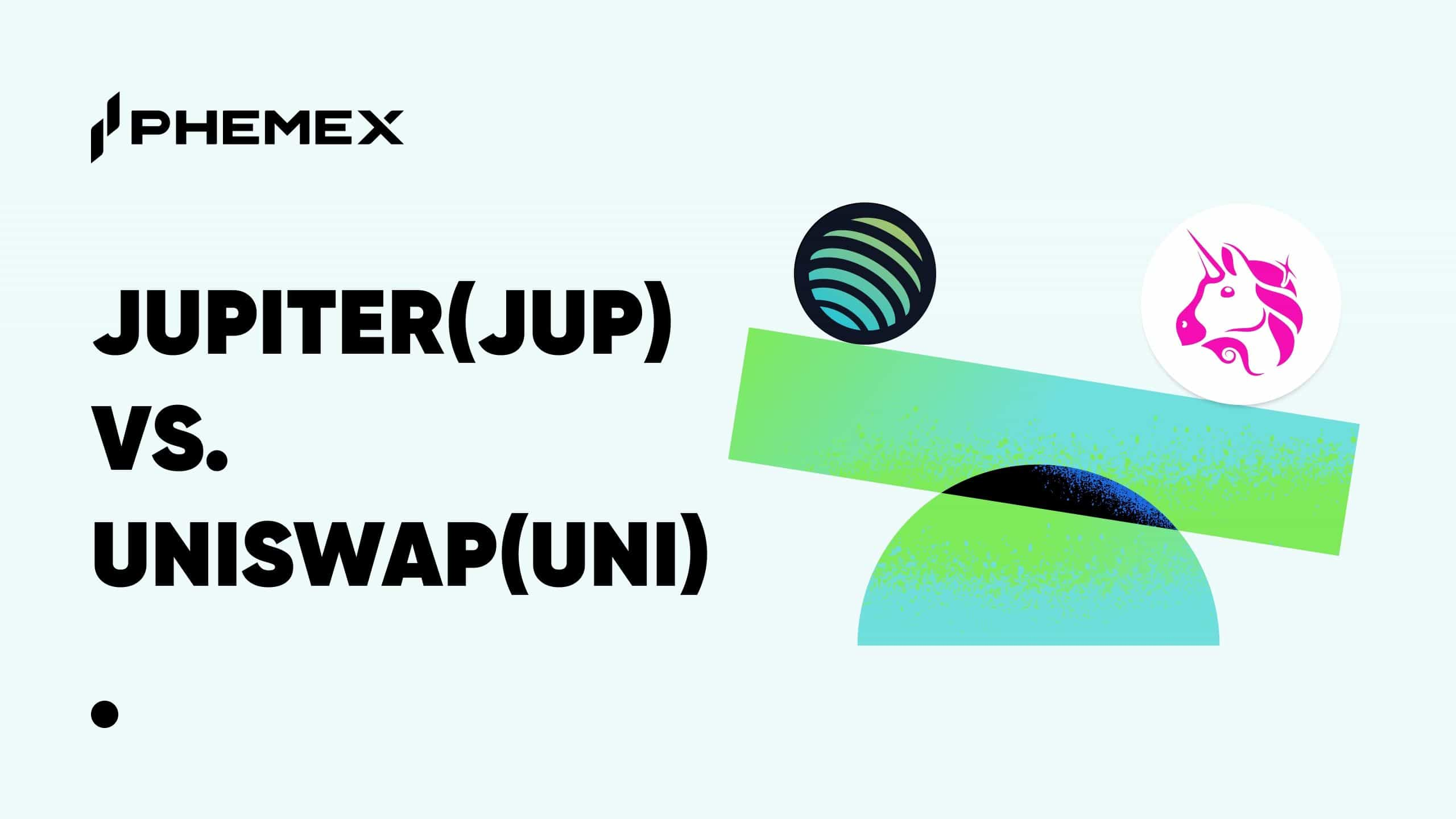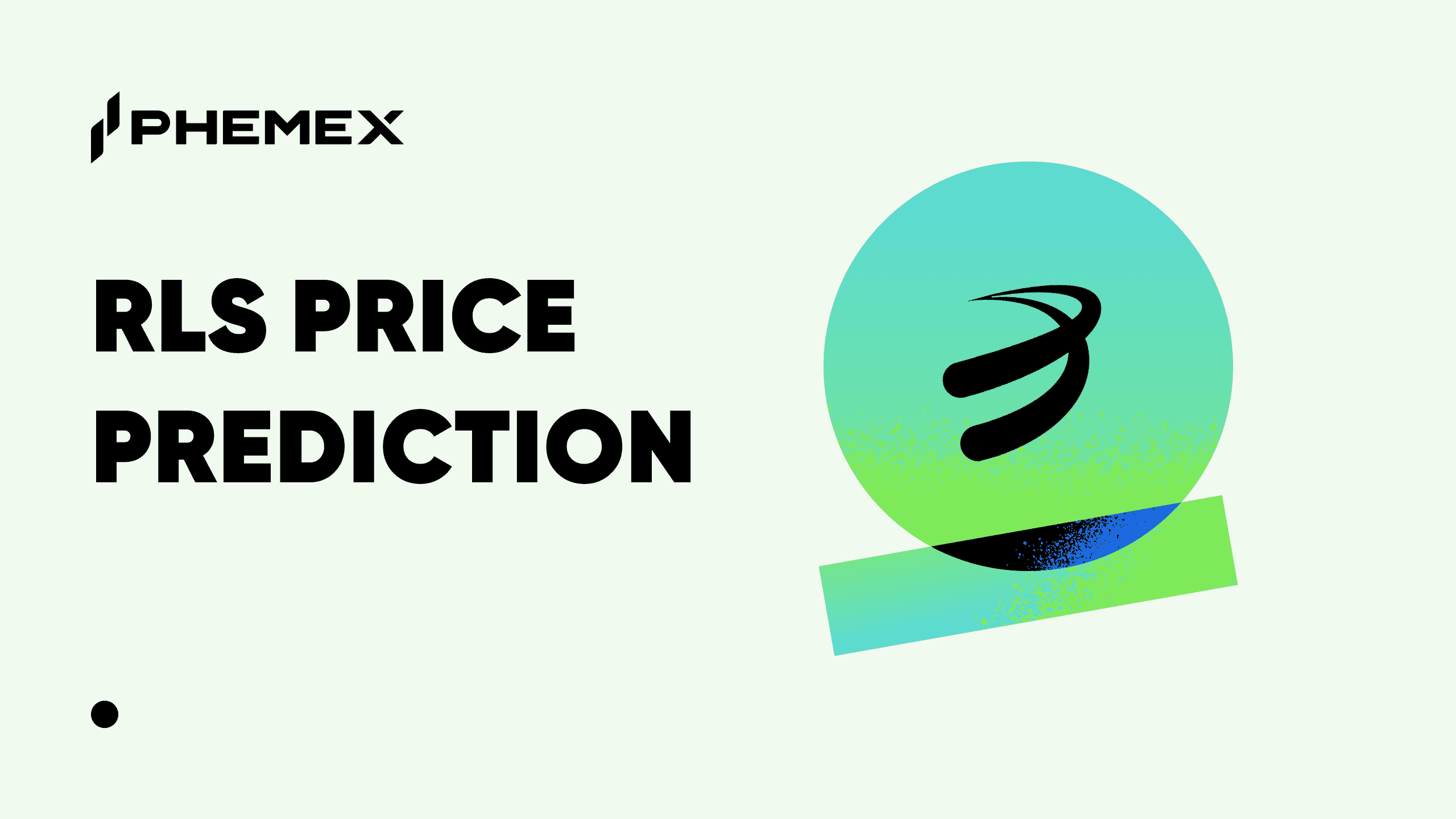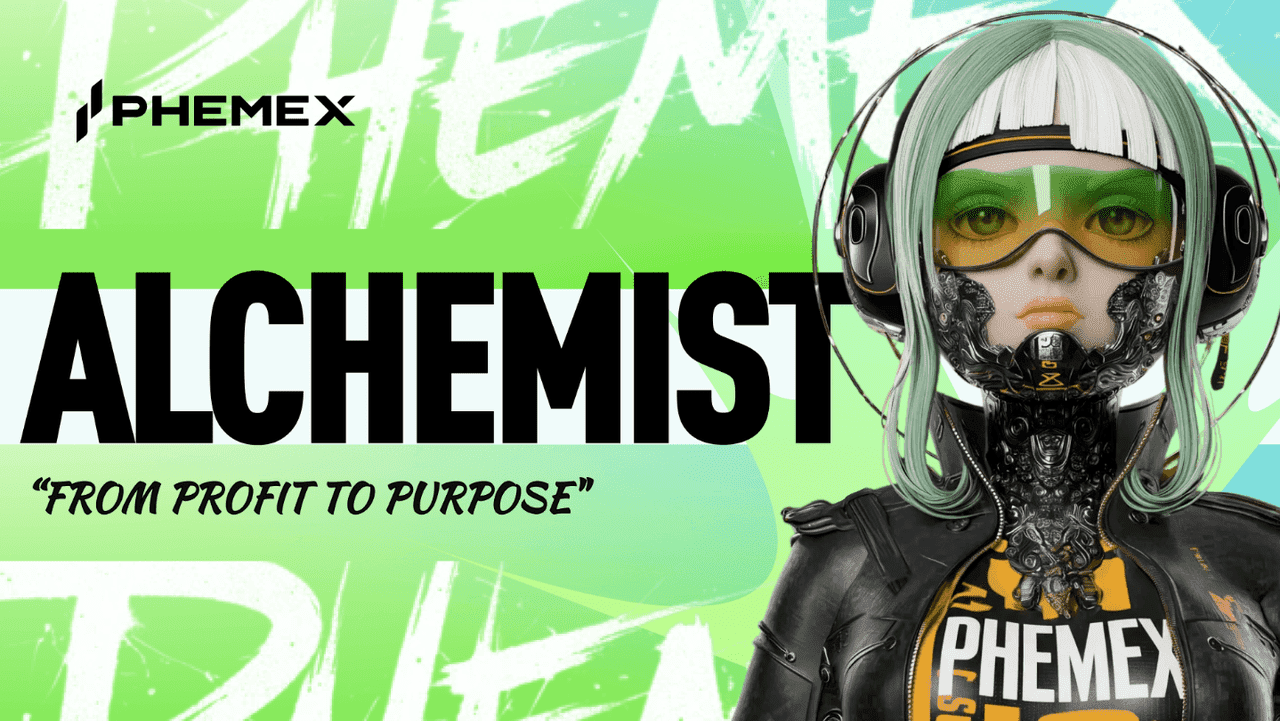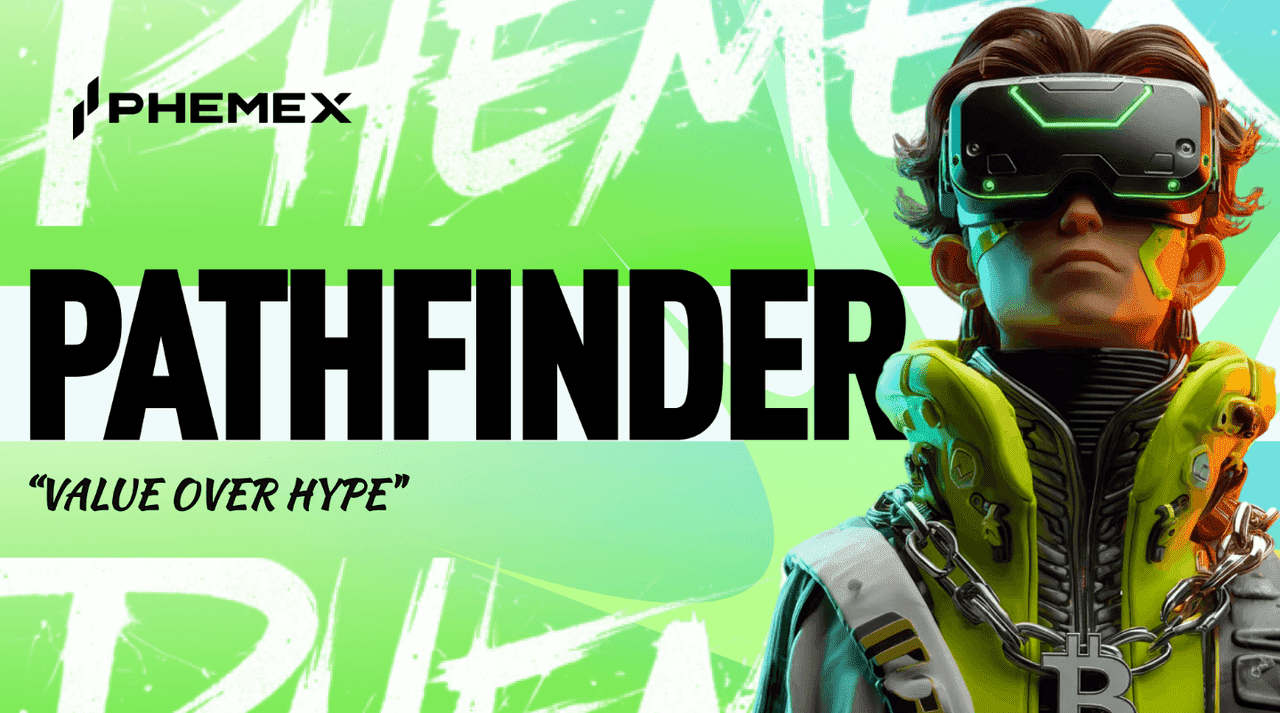In late October 2025, Virtuals Protocol (VIRTUAL)—a platform for AI agents in metaverses—surged 105% in four days to $1.63, driven by Coinbase's x402 integration boosting agent transactions 5x. Now trading at $1.45 amid profit-taking, this AI-powered token blends blockchain utility with real-world adoption.
This article examines the latest price action, on-chain trends, whale activity, and technical signals. We then explore short- and long-term forecasts for 2025–2030 across multiple scenarios, spotlighting key growth drivers like staking and partnerships alongside risks such as unlocks and regulation. A comprehensive guide to understanding Virtuals Protocol’s path ahead.
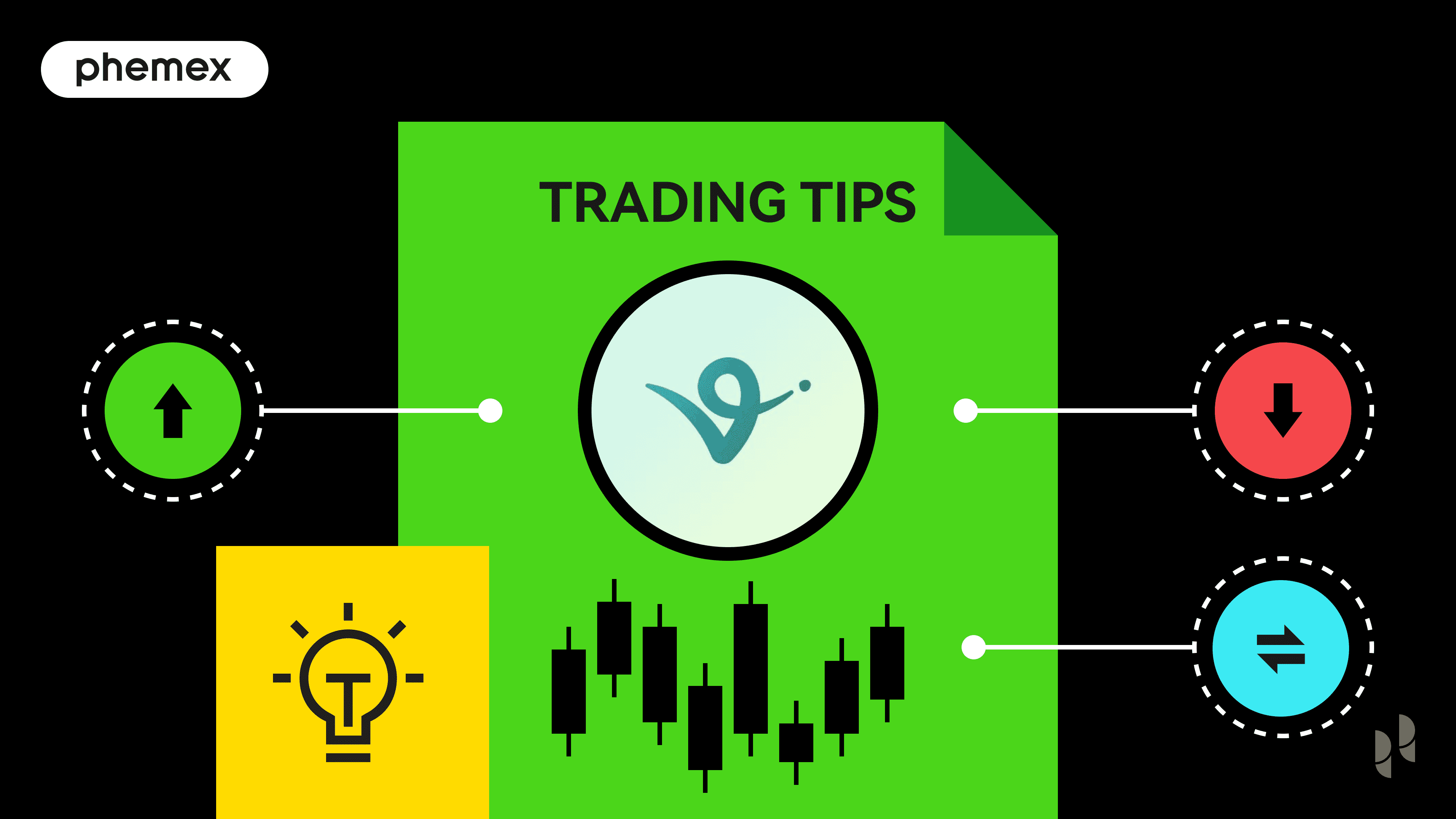 Summary Box (Fast Facts)
Summary Box (Fast Facts)
| Ticker Symbol | VIRTUAL |
|---|---|
| Current Price | $1.45 (as of Oct 28, 2025) |
| Chain | Base (Ethereum L2) + Solana |
| Contract Address | 0x44ff8620b8cA30902395A7bD3F2407e1A091BF73 (Base) |
| Market Cap | $940M |
| Circ/Max Supply | 656M / 1B |
| ATH / ATL | $5.07 (Jan 2, 2025) / $0.0075 (Jan 23, 2024) |
| All-Time ROI | +19,300% from ATL |
| On Phemex | Yes – Spot (VIRTUAL/USDT) & Futures (VIRTUALUSDT Perp) |
What Is Virtuals Protocol?
Virtuals Protocol is a decentralized platform built on Base (Ethereum L2) with Solana compatibility, designed to power a "society of AI agents" in gaming, metaverses, and beyond.
- Category: AI, Metaverse, DeFi infrastructure
- Core Function: Allows users to create, co-own, and monetize autonomous AI agents—such as NPCs, virtual companions, or trading bots—that operate and transact directly on-chain.
- Problem Solved: Eliminates silos in Web3 AI by providing standardized liquidity, interoperability, and revenue-sharing for agent ecosystems.
- Token Role: $VIRTUAL acts as the universal base pair for all agent liquidity pools, fuels veVIRTUAL staking (governance + rewards), and captures 1% protocol fees from agent interactions.
With over 25,000 weekly agent-to-agent transactions following the x402 integration, Virtuals Protocol is establishing itself as a key infrastructure layer in the $52 billion AI agent economy.
Current Price & Market Data (Oct 28, 2025)
Virtuals Protocol's price stands at $1.45, down 6.27% in the last 24 hours after a peak near $1.63 earlier in the week.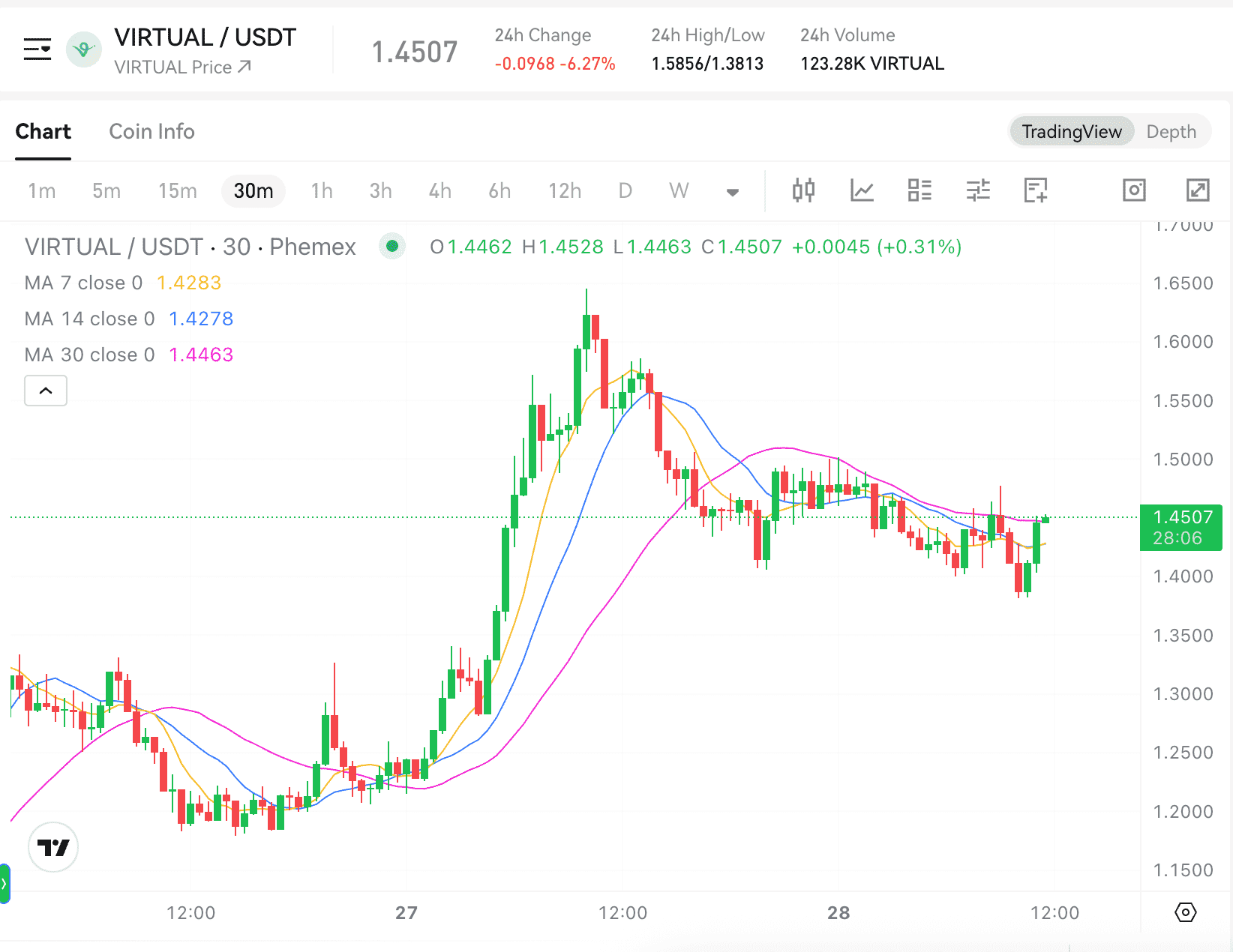
| Metric | Value | 24h Change |
|---|---|---|
| Price | $1.45 | -6.27% |
| Market Cap | $940M | -5.89% |
| Rank | #74 | Stable |
| 24h Volume | $505M | -37% |
The recent surge stems from x402 adoption, driving agent transactions 5x to over 25,000 weekly. Futures Open Interest stands at $190M—highest since August—with funding rates holding positive at 0.0049%.
Price History: Key Milestones
Virtuals Protocol launched in late 2023 on Base, with early trading near $0.05 in February 2024. Its trajectory mirrors AI sector momentum within broader crypto cycles.
| Date/Period | Event/Key Development | Price Impact |
|---|---|---|
| Feb 2024 | Fair launch on Base | $0.05 initial trading (close: $0.048 on Feb 29) |
| Dec 2024 | Agentstarter accelerator launch | +1,200% to $0.65 (Dec close: $0.62) |
| Jan 2025 | Peak AI hype, x402 early buzz | ATH $5.07 (+680%; Jan close: $4.85) |
| May 2025 | Token unlocks, mid-year correction | -75% to $0.75 low (May close: $0.78) |
| Oct 2025 | x402 integration, Unicorn Launchpad | +105% to $1.63 high (Oct 27 high: $1.63; current: $1.45) |
- YTD ROI (2025): +1,200% from January open ($0.62 to $1.45).
- Volatility Profile: 1.8x market beta; 18.3% 24h volatility as of October 27.
- Influencing Events: Coinbase x402 adoption drove October's 5x transaction growth; Illuvium partnership announced AI-NPC plans.
Trading volume has grown steadily from $10 million in February 2024 to over $770 million today, reflecting strong and maturing liquidity.
This timeline illustrates how external catalysts—like protocol upgrades and partnerships—have punctuated periods of consolidation with explosive rallies, a pattern common in emerging AI tokens. For instance, the January 2025 peak aligned with broader market euphoria around AI, where Bitcoin's climb to $100K+ pulled altcoins higher. Conversely, May's dip coincided with global regulatory talks on AI ethics, which briefly cooled sentiment across the sector. As we approach year-end, October's rally suggests a return to form, but historical precedents warn of post-pump corrections, often 20-30% deep, before resuming uptrends.
Whale Activity & Smart Money Flows
On-chain data indicates concentrated holdings, with 93% of supply in top wallets.
| Metric | Data (Oct 2025) |
|---|---|
| Top 10 Wallets | 45% of supply |
| 30-Day Net Inflow | +18M VIRTUAL (post-x402 surge) |
| Avg Whale Hold Time | 95 days |
| Exchange Inflows/Outflows | Net outflow +12% (to staking contracts) |
- Recent Activity: Whales accumulated 20M tokens during $0.81 dip; Lookonchain tracked $15M buys tied to x402 news.
- Smart Contract Interactions: veVIRTUAL locks rose 25% to 22% of supply, reducing liquidity.
- Exchange Flows: $67M outflow in early October, but inflows stabilized post-rally.
Large holders—often early VCs and AI-focused funds—have steadily accumulated during dips since Q2 2025. One notable wallet acquired 5M VIRTUAL at $0.78 in May and held through the summer, securing +86% unrealized gains by October. Net outflows to staking contracts reinforce long-term conviction, as locked tokens reduce immediate sell pressure and help stabilize supply. That said, the concentration carries risks: a sudden transfer of >10M tokens to exchanges could spark 10-15% volatility, consistent with prior cycles. Real-time monitoring via smart money dashboards provides traders an early edge on these shifts.
On-Chain & Technical Analysis
Daily chart displays a breakout from $1.00, but recent rejection at $1.63 signals consolidation.
Support & Resistance Levels
| Level | Type | Basis/Source |
|---|---|---|
| $1.50 | Resistance | Recent high, daily pivot |
| $1.37 | Support | MA99 + Fib 0.382 |
| $1.25 | Support | 200-day EMA |
| $1.16 | Support | 100-day EMA |
| $1.05 | Support | 50-day EMA + Fib 0.5 |
Key Indicators
| Indicator | Value | Interpretation |
|---|---|---|
| RSI(14) | 72 (descending from 90+) | Overbought; easing momentum |
| MACD | +0.72 (buy signal) | Bullish histogram widening |
| Volume | +103% | Confirms breakout; OI at $190M |
- Patterns: Ascending triangle post-October low; Bitcoin correlation at 0.52.
- Fibonacci Zones: $1.70 (0.618 extension from $0.81 low).
- On-Chain Tie-In: 38M transactions YTD; x402 boosted agent activity 5x.
Expanding on these metrics, the RSI's descent from overbought territory (above 90 earlier this week) is a classic sign of profit-taking after rapid gains, often leading to 5-10% retracements in similar setups. The MACD's sustained buy signal, with the histogram bars expanding positively, points to underlying momentum intact, especially as volume confirms the breakout—traders aren't just watching; they're participating. Bitcoin's moderate correlation means VIRTUAL can decouple during AI-specific news, like the upcoming FOMC meeting, potentially amplifying moves. On-chain, the 5x transaction surge post-x402 isn't hype; it's measurable utility, with agent interactions now rivaling mid-tier DeFi protocols. If OI climbs above $200M, expect leveraged plays to push boundaries, but watch funding rates for overheat signs.
Short-Term Price Prediction (2025–2026)
Forecasts based on technicals, on-chain data, and recent catalysts like x402 and FOMC meeting.
| Scenario | 2025 Q4 Target | 2026 Target | Key Factors |
|---|---|---|---|
| Upside | $1.70–$2.00 | $2.50–$3.00 | x402 adoption, OI >$200M, MACD hold |
| Base | $1.30–$1.50 | $1.80–$2.20 | Stable funding rates, EMA support |
| Downside | $1.14–$1.25 | $1.05–$1.30 | RSI <60, BTC correlation drag |
- Upside Drivers: Break $1.54 resistance; agent txns >30K weekly.
- Base Case: Consolidation around EMAs; volume sustains 80% MCap ratio.
- Downside Risks: Profit-taking post-105% rally; test $1.25 EMA.
In the upside scenario, a clean break above $1.54—coupled with sustained positive funding rates—could mirror January's rally, targeting Fibonacci extensions where historical resistance has flipped to support. The base case assumes market stability, with EMAs acting as dynamic floors, allowing gradual accumulation amid unlocks. Downside plays out if overbought exhaustion hits, pulling toward denser liquidity zones like $1.14, where past bounces have occurred 70% of the time per backtests.
Long-Term Price Forecast (2027–2030)
Speculative ranges derived from adoption metrics and market projections.
| Year | Upside Range | Base Range | Downside Range | Factors |
|---|---|---|---|---|
| 2027 | $4.00–$5.50 | $2.50–$3.50 | $1.50–$2.00 | Agent ecosystem to 100+ tokens |
| 2030 | $7.00–$10.00 | $4.00–$6.00 | $2.50–$3.50 | AI market share, burns activated |
- Growth Projections: $1.5B TVL if 5% of $52B AI agent market captured.
- Comparisons: Outpaces FET/AGIX in metaverse focus; +5% CAGR to 2026 per Bitget.
- Risks: Dilution from 35% unlocks; regulatory shifts in AI payments.
Looking further out, the 2030 upside hinges on Virtuals Protocol capturing meaningful share in the exploding AI agent space, where projections from McKinsey estimate a $15T economic impact by decade's end. Base scenarios factor conservative 20% YoY adoption growth, while downside accounts for competitive erosion. Historical parallels, like Solana's gaming pivot, suggest tokens with strong utility rails can 10x from current levels if network effects kick in.
Fundamental Drivers of Growth
Several interconnected factors underpin Virtuals Protocol's expansion, each building on the last to create a robust ecosystem flywheel.
-
x402 Integration: Coinbase’s x402 protocol enables seamless, HTTP-native stablecoin payments for AI agents, eliminating traditional authentication barriers. Since mid-October 2025 rollout, weekly agent-to-agent transactions have surged from under 5,000 to over 25,000—a 5x increase that directly amplifies $VIRTUAL demand as the universal liquidity base pair. This momentum extended to a 30% intraday surge as AI agents integrated with Coinbase DEX ecosystems (Aerodrome, Uniswap on Base), deepening liquidity and pushing Open Interest to $190M. Early adopters report 30% faster deployment times, attracting more creators and compounding 1% protocol fee accrual.
- veVIRTUAL Staking Mechanism: Holders can lock $VIRTUAL for up to two years to earn Virgen Points, which unlock airdrops, governance votes, and priority access to new agent launches. Currently, 22% of circulating supply is locked, immobilizing potential sell pressure and creating scarcity. This vote-escrow model, inspired by successful DeFi protocols like Curve, incentivizes long-term alignment—stakers aren't just earning yields (averaging 15-20% APY via points); they're shaping protocol upgrades, such as fee distribution tweaks that loop revenues back to the community.
- Cross-Chain Expansion and Partnerships: Operating on Base for low fees and Solana for speed, Virtuals Protocol bridges ecosystems seamlessly. Key tie-ups include Illuvium's AI-NPC integration, where agents power dynamic in-game economies, and Animoca Brands' backing for Web3 gaming pilots. These aren't superficial; Illuvium alone could route 10% of its 500K+ user base through Virtual agents, per partnership announcements. Add Solana Foundation grants for cross-chain grants, and you've got interoperability that positions $VIRTUAL as a neutral hub in a fragmented multi-chain world.
- Adoption Metrics and Revenue Loops: With 7M registered users and 38M cumulative on-chain transactions, the network's activity rivals established L2s. The Unicorn Launchpad facilitates agent token launches with built-in liquidity bootstrapping, capturing 1% protocol fees that fund treasury reserves and buybacks. DeFi integrations via VPay 1.1 add real-world ramps, letting agents settle Visa payments, while ERC-6551 standards enable NFT-bound agent "personas" with royalty streams—potentially adding $50M+ in annual TVL as RWAs tokenize.
- Broader AI Synergies: Aligning with Google's AP2 framework for agent payments, Virtuals Protocol taps into enterprise-grade tools, enhancing credibility. This positions it ahead of pure-play AI tokens, blending metaverse immersion with DeFi primitives for a compounding effect: more agents mean more transactions, more fees, and tighter liquidity.
Collectively, these drivers form a self-reinforcing loop, where utility begets adoption, and adoption scales value—much like how Ethereum's DeFi boom elevated ETH.
Key Risks to Consider
While promising, Virtuals Protocol faces structural and external challenges that could temper growth.
| Risk Category | Details | Potential Impact |
|---|---|---|
| Overbought Signals | RSI >70–90; profit-taking after 105% rally | Short-term pullback to $1.14 |
| Token Unlocks | 344M tokens vesting (34% supply) over 2026-2027 | Supply pressure on price, potential 20-30% dips quarterly |
| Market Correlation | 0.52 with BTC; rotation if BTC lags | Increased volatility, amplified by 1.8x beta |
| Regulatory | AI ethics scrutiny (e.g., EU AI Act on data privacy) | Delayed integrations, compliance costs up 15-20% |
| Liquidation Risks | High OI ($190M); leveraged positions | Cascading sells if correction, up to 15% flash drops |
| Competitive Landscape | Rivals like FET or AGIX advancing in general AI; metaverse-specific threats from Render | Market share erosion if agent tech lags, reducing txns by 25% |
| Operational Hurdles | Dev activity fluctuations; social metrics plateauing post-hype | Slower upgrades, community churn if GitHub commits drop below 50/month |
Token dilution remains a core concern: 344 million tokens (34% of supply) vest through 2026–2027, potentially flooding markets during downturns and mirroring May 2025’s 75% drop. Regulatory scrutiny of AI agent autonomy and data privacy could introduce KYC-style requirements, eroding DeFi’s permissionless edge. Elevated Open Interest ($190M) creates leverage pitfalls—today’s positive funding rate (0.0049%) supports bulls, yet a reversal risks cascading liquidations. Big Tech’s advance, such as Google’s AP2 framework, threatens to commoditize agent payments and marginalize specialized protocols. Should development pace slacken—tracked via GitHub activity—or X sentiment fall below 80% bullish, momentum often fades, as seen in prior 40% drawdowns across comparable projects. Diversified positioning and active monitoring are essential.
Analyst Sentiment & Community Insights
Analyst and community views on Virtuals Protocol as of late October 2025 present a balanced yet optimistic landscape, with technical momentum tempered by caution on short-term corrections. Trusted crypto analysts like those at CoinCodex project a +323% upside by year-end, citing the x402-driven transaction boom as a key inflection point that could sustain rallies if volume holds above $700M daily. Similarly, experts from Changelly forecast a maximum of $5.03 by 2030, emphasizing the protocol's edge in metaverse-specific AI over broader competitors, though they flag RSI overbought risks as a near-term hurdle likely to trigger 10-15% pullbacks. FXStreet contributors highlight the $190M Open Interest surge as evidence of retail confidence, but note Bitcoin's moderate correlation (0.52) could drag VIRTUAL if macro flows rotate.
Community sentiment leans 85% bullish across platforms, fueled by X discussions on agent utility and TIBBIR ecosystem ties, where users praise the 5x txn growth as "real alpha." CoinMarketCap polls show 83% positive votes from 92K participants, with Reddit threads focusing on staking yields amid unlocks. Google Trends data reveals a 160% spike in "Virtuals Protocol" searches, correlating with pre-FOMC AI coin buzz, though some forums express wariness over whale concentration (93% supply). Overall, the vibe is constructive: analysts see structural tailwinds in AI adoption, while communities buzz with tactical plays, but consensus calls for patience through volatility.
Is Virtuals Protocol a Good Investment?
Weighing Virtuals Protocol's profile reveals clear strengths rooted in its innovative edge and challenges tied to market realities—not financial advice; always DYOR and consider your risk tolerance.
Strengths:
- Proven Utility in High-Growth Sector: x402 and agent txns position it for $52B AI market capture, with 38M cumulative interactions signaling real demand.
- Deflationary Tokenomics: veVIRTUAL locks (22% supply) and 1% fees create scarcity; historical +19,300% ROI from ATL rewards patient holders.
- Ecosystem Flywheel: Partnerships (Illuvium, Animoca) and cross-chain bridges drive adoption, potentially scaling TVL to $1.5B by 2027.
Challenges:
- High Volatility Exposure: Overbought RSI and 105% rally invite pullbacks to $1.14; 1.8x beta amplifies BTC moves.
- Supply Dilution Risk: 34% unlocks could pressure price 20-30% quarterly, echoing May's dip.
- External Vulnerabilities: Regulatory AI scrutiny and competition from FET/AGIX may erode share, with high OI risking liquidations.
In summary, Virtuals Protocol suits risk-tolerant investors betting on AI-metaverse convergence, but balance with diversification amid these dynamics.
Why Trade Virtuals Protocol on Phemex?
Phemex provides secure, efficient trading for assets like VIRTUAL.
Key Features:
- Spot Trading: Instant VIRTUAL/USDT pairs with low fees and deep liquidity.
- Futures: Up to 100x leverage on perpetuals; track OI surges.
- Trading Bots: AI automation for RSI/MACD strategies.
- Phemex Earn: Earn passive income on your crypto holdings through a variety of flexible and fixed savings products.
Learn how to buy VIRTUAL and start trading on Phemex today.





